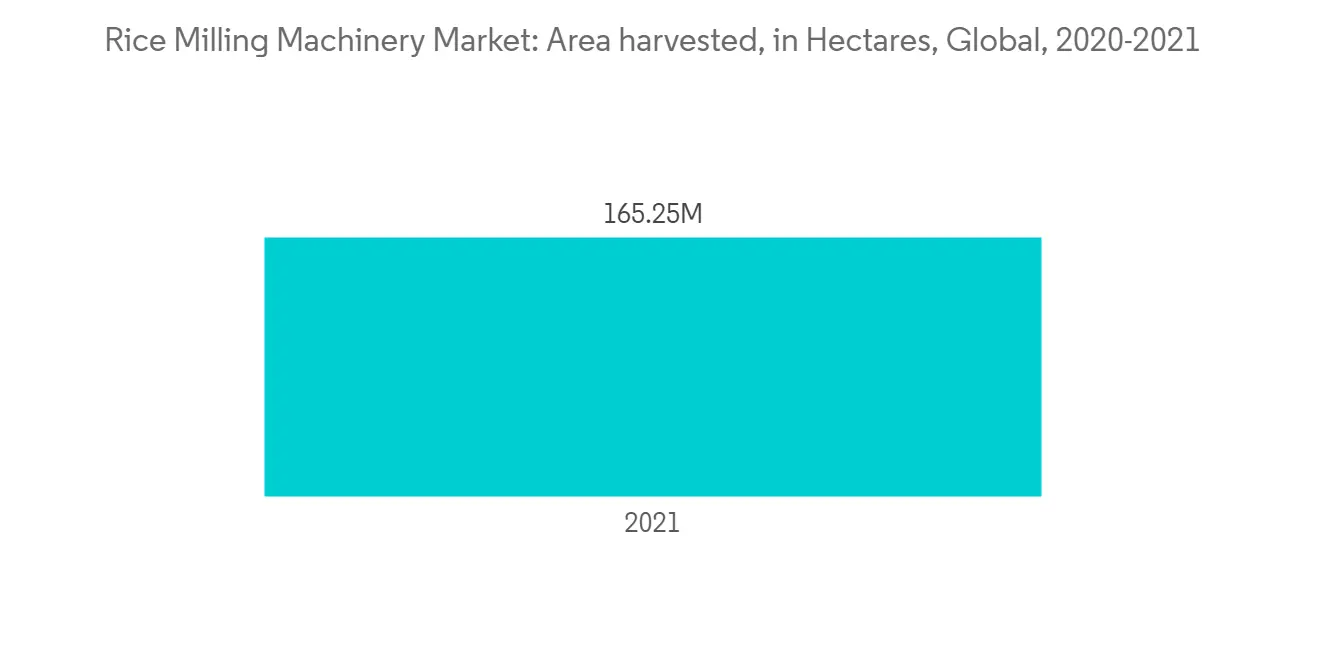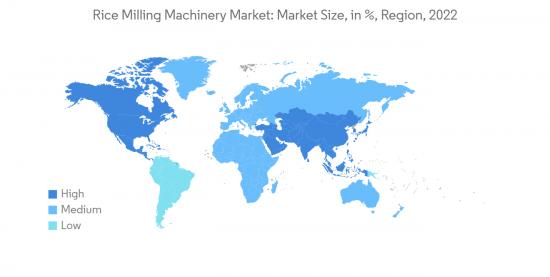
|
市場調査レポート
商品コード
1331385
精米機の市場規模・シェア分析- 成長動向と予測(2023年~2028年)Rice Milling Machinery Market Size & Share Analysis - Growth Trends & Forecasts (2023 - 2028) |
||||||
カスタマイズ可能
適宜更新あり
|
|||||||
| 精米機の市場規模・シェア分析- 成長動向と予測(2023年~2028年) |
|
出版日: 2023年08月08日
発行: Mordor Intelligence
ページ情報: 英文 120 Pages
納期: 2~3営業日
|
- 全表示
- 概要
- 目次
精米機市場規模は2023年に2億3,014万米ドルと推計され、2028年には2億8,000万米ドルに達すると予測され、予測期間中(2023-2028年)にCAGR 4%で成長すると予測されます。
主なハイライト
- 世界人口の半分以上が主食としている米は世界中で生産されており、その約90%はアジアで栽培されています。中国はアジア最大の米生産国です。インディカ米、アロマティック米(ジャスミン米、バスマティ米)、ジャポニカ米、もち米が4大品種であるが、その他多くの特殊品種も世界的に生産されています。
- 認証精米機への需要が精米機市場の成長を牽引しています。認証された精米機は高品質の米加工を保証するためであり、これは増大する米需要を満たすために必要です。米は多くの国で主食であるため、米の需要は当面高止まりすると予想されます。そのため、精米機の需要も引き続き増加することが予想されます。
- しかし、精米機の中古モデルが入手可能であることが、市場の成長を阻害する可能性があります。精米技術の最新動向としては、サタケのNTWP(New Tasty White Process)が画期的です。NTWPプロセスは、味と外観の点で品質が向上した無洗米を生産します。この技術は、水の使用量と処理時間を削減しながら、より高品質な米を提供することで、精米業界に革命を起こす可能性を秘めています。これは精米業者にとって、効率の向上、コストの削減、ひいては利益の増加につながる可能性があります。
- 世界人口の増加に伴い米の需要は拡大しており、多くの精米工場が新しい精米所を開設し、市場の成長を後押ししています。インドはバスマティ米の最大の生産国であり、輸出国でもあります。精米はおそらくインドで最も古く、最大の農産物加工産業です。国連食糧農業機関(FAO)によると、インドの2020年の籾米生産量は約1億1,700万トンで、これは約9,000万トンの精米に相当します。
精米機の市場動向
稲作面積の増加
- 米は世界人口の半数以上にとって主要な主食であり、アジア、サハラ以南のアフリカ、南米が最大の消費地域です。アジアは最大の米生産国で、その中には中国やインドなど、米の生産量・消費量ともに最大級の国々が含まれています。国連食糧農業機関(FAO)によると、2021年の総収穫面積はインドが4,620万トンを占め、次いで中国が2,990万トン、バングラデシュが1,170万トン、タイが1,120万トン、インドネシアが1,040万トンとなっています。この収穫面積の増加は、籾から米を抽出して消費するための精米機の必要量の増加を示しています。
- 米国農務省(USDA)の報告書(2021年)によると、4つの地域が米国の米生産のほぼ全量を生産している:アーカンソー・グランドプレーリー、ミシシッピ・デルタ、メキシコ湾岸、カリフォルニアのサクラメント・バレーです。それぞれの地域は通常、特定の種類の米に特化しており、米国では長粒種、中粒種、短粒種と呼ばれています。
- 米国の長粒種は一般的に乾燥しており、炊くと分離します。一般的に、長粒種は米国産米の約75%を占め、中粒種は約24%、残りは短粒種です。2021年、米国の粗米生産量は1億9,180万トンで、2020年比16%減だが、2019年をわずかに上回る。
- 水稲栽培は、高温、高湿度、豊富な降雨量などの特定の気候条件を持つ地域に限定されます。そのため、主に中国、インド、東南アジアなどのアジア地域や、アフリカ、南米地域で栽培されています。しかし、高収量品種の導入が進み、交互湿潤乾燥(AWD)などの新しい栽培技術が導入されたことで、以前は適地でなかった地域でも米の栽培が可能になっています。
- 高品質米に対する需要の高まりと、新しい栽培技術や高収量品種の採用の増加は、精米機市場のプレーヤーに大きな機会をもたらしています。これらのプレーヤーは、精米プロセスの効率を改善し、人件費を削減し、最終製品の品質を高めることができる先進的な機械を提供することができます。

アジア太平洋が市場を独占
- 米、小麦、トウモロコシは世界中で消費される主食作物であるが、米はその中でも主要な主食作物であり、世界人口の半数以上が1日に必要なカロリーを満たすのに役立っています。世界の米の90%以上はアジアで栽培されており、主に中国、インド、インドネシア、バングラデシュで生産されています。
- 国連食糧農業機関(FAO)によると、2021年の総収穫面積はインドが4,620万トン、次いで中国が2,990万トン、バングラデシュが1,170万トン、タイが1,120万トン、インドネシアが1,040万トンとなっています。
- 稲作の総合作物管理(ICM)アプローチには、その土地固有の技術と、政府、研究機関、改良普及サービスによる効果的な制度的支援が組み合わされています。このアプローチは、利用可能な資源の利用を最適化し、病害虫の影響を最小限に抑え、稲作の全体的な生産性と持続可能性を向上させることを目的としています。ICMのアプローチを用いることで、農家は収量ギャップを埋め、米の生産量を増やすことができます。政府は、投入資材や村の信用供給へのアクセスを提供したり、新しい知識や技術を普及させるための研究や改良普及の連携を強化したりすることで、農家を支援することができます。
- FAOによれば、2025年までにアジアにおける米の消費量は51%以上増加します。この地域の人口増加による米需要の増加が、予測期間中の精米市場を牽引すると思われます。

精米機産業の概要
精米機市場は断片化されており、少数の大手プレーヤーが小規模プレーヤー間の競合を引き起こしています。Buhler Group、Fowler Westrup、MillTECH Machinery Private Ltd、Savco Sales Pvt.Ltd、Satake Groupは、世界中に販売・製造拠点を持つ著名なプレーヤーです。新製品の発売、パートナーシップ、買収は、国内市場の大手企業が採用する主要戦略です。
技術革新や事業拡大とともに、研究開発への投資や斬新な製品ポートフォリオの開発も、今後数年間は重要な戦略となりそうです。これらの企業は、国内企業と提携することで戦略的パートナーシップを結び、流通網を拡大し、各地域の農家のニーズに応える革新的な製粉機械を新たに発売しています。
その他の特典:
- エクセル形式の市場予測(ME)シート
- 3ヶ月間のアナリスト・サポート
目次
第1章 イントロダクション
- 調査の前提と市場定義
- 調査範囲
第2章 調査手法
第3章 エグゼクティブサマリー
第4章 市場力学
- 市場概要
- 市場促進要因
- 市場抑制要因
- ポーターのファイブフォース分析
- 新規参入業者の脅威
- 買い手の交渉力
- 供給企業の交渉力
- 代替品の脅威
- 競争企業間の敵対関係の強さ
第5章 市場セグメンテーション
- メカニズム
- 分づき精米機
- 精米機
- オペレーション
- 前洗米機
- 選別機
- 等級分け機械
- 精米機
- その他
- 地域
- 北米
- 米国
- カナダ
- メキシコ
- その他北米地域
- 欧州
- ドイツ
- 英国
- フランス
- イタリア
- スペイン
- その他欧州
- アジア太平洋
- インド
- 中国
- 日本
- その他アジア太平洋地域
- 南米
- ブラジル
- アルゼンチン
- その他南米
- アフリカ
- 南アフリカ
- その他のアフリカ
- 北米
第6章 競合情勢
- 最も採用されている戦略
- 市場シェア分析
- 企業プロファイル
- Buhler AG
- Fowler Westrup
- AG Growth International Inc.
- MillTECH Machinery Private Ltd
- Yamanoto
- Zhejiang QiLi Machinery Co. Ltd
- Satake Corporation
- Mill Master Machinery Pvt. Ltd
- G S International
- G.G. Dandekar Machine Work
- Hubei Bishan Machinery Co. Ltd
第7章 市場機会と今後の動向
The Rice Milling Machinery Market size is estimated at USD 230.14 million in 2023, and is expected to reach USD 280 million by 2028, growing at a CAGR of 4% during the forecast period (2023-2028).
Key Highlights
- Rice, the primary staple for more than half the world's population, is produced worldwide, with about 90 percent grown in Asia. China is the largest producer of rice in Asia. While Indica, Aromatic(Jasmine and Basmati), Japonica, and Glutinous rice are four major categories of rice, many other specialty varieties of rice are also produced globally.
- The demand for certified rice milling machinery is driving the growth of the rice milling machinery market. This is because certified machinery ensures high-quality rice processing, which is necessary to meet the growing demand for rice. As rice is a staple food in many countries, the demand for rice is expected to remain high in the foreseeable future. This, in turn, will continue to drive the demand for rice milling machinery.
- However, the availability of pre-used models of rice milling machinery may impede the market growth. Regarding the latest development in rice milling technology, the Satake New Tasty White Process (NTWP) is a breakthrough in rice processing. The NTWP process produces rinse-free rice of enhanced quality in terms of taste and appearance. This technology has the potential to revolutionize the rice milling industry by offering higher-quality rice while reducing water usage and processing time. This could lead to increased efficiency, reduced costs, and ultimately, higher profits for rice millers.
- The stipulation for rice is expanding with the rising global population, which led to many rice processing plants opening new rice mills and boosting the market's growth. India is the largest producer and exporter of Basmati rice and one of the largest exporters of rice. Rice milling is perhaps the country's oldest and biggest agro-processing industry. According to the Food and Agriculture Organization of the United Nations (FAO), India produced around 117 million metric tons of paddy rice in 2020, which is equivalent to around 90 million metric tons of milled rice.
Rice Milling Machinery Market Trends
Rising Area Under Rice Cultivation
- Rice is the primary staple food for more than half the world's population, with Asia, Sub-Saharan Africa, and South America as the largest consuming regions. Asia is the largest producer of rice, including countries like China and India, which are among the largest producers and consumers of rice. According to the Food and Agriculture Organization (FAO), in 2021, the total area harvested by India accounted for 46.2 million metric tons, followed by China with 29.9 million metric tons, Bangladesh with 11.7 million metric tons, Thailand with 11.2 million metric tons, and Indonesia with 10.4 million metric tons. This increase in the area harvested shows the increase in the requirement for more milling machinery to extract rice from paddy for consumption.
- According to the United States Department of Agriculture (USDA) report 2021, four regions produced almost the entire United States rice crop production: Arkansas Grand Prairie, Mississippi Delta, Gulf Coast, and Sacramento Valley of California. Each region normally specializes in a specific type of rice, referred to in the United States by the long, medium, and short grain length.
- The United States long-grain rice is typically dry and separates when cooked, while medium- and short-grain rice are typically moist and clingy. In general, long-grain production accounts for around 75 percent of United States rice production, medium-grain production for about 24 percent, and short-grain for the remainder. In 2021, the United States produced 191.8 million hundredweight (cwt) of rough rice, down 16 percent from 2020 but slightly above 2019.
- Paddy rice cultivation is limited to areas with specific climatic conditions, such as high temperatures, high humidity, and abundant rainfall. As a result, it is grown primarily in regions of Asia, such as China, India, and Southeast Asia, as well as in regions of Africa and South America. However, the rising adoption of high-yielding varieties and new cultivation techniques, such as alternate wetting and drying (AWD), has allowed for increased rice cultivation in areas that were previously unsuitable.
- The rising demand for high-quality rice and the increasing adoption of new cultivation techniques and high-yielding varieties presents a significant opportunity for players in the rice milling machinery market. These players can offer advanced machines that can improve the efficiency of the rice milling process, reduce labor costs, and increase the quality of the final product.

Asia-Pacific Dominates the Market
- Rice, wheat, and corn are the major consumed staple crops worldwide, whereas rice is a major staple crop among the three, helping more than half of the global population meet its daily calorie requirements. More than 90 percent of the world's rice is grown in Asia, principally in China, India, Indonesia, and Bangladesh, with smaller amounts grown in Japan, Pakistan, and various Southeast Asian nations.
- According to the Food and Agriculture Organization (FAO), in the year 2021, the total area harvested by India accounted for 46.2 million metric tons, followed by China with 29.9 million metric tons, Bangladesh with 11.7 million metric tons, Thailand with 11.2 million metric tons and Indonesia with 10.4 million metric tons.
- Integrated Crop Management (ICM) approaches for rice crops involve location-specific technologies combined with effective institutional support from governments, research institutions, and extension services. This approach aims to optimize the use of available resources, minimize the impact of pests and diseases, and improve the overall productivity and sustainability of rice farming. Using ICM approaches, farmers can bridge the yield gap and increase their rice production. Governments can support farmers by providing access to input and village credit supplies, as well as strengthening research and extension linkages to disseminate new knowledge and technologies.
- According to FAO, rice consumption in Asia by 2025 will increase by more than 51 percent. This increase in demand for rice due to the population increase in the region will drive the rice milling market during the forecast year.

Rice Milling Machinery Industry Overview
The rice milling machinery market is fragmented with a few big players, resulting in competition between small players. Buhler Group, Fowler Westrup, MillTECH Machinery Private Ltd, Savco Sales Pvt. Ltd and Satake Group are some of the prominent players with their distribution and manufacturing facilities worldwide. New product launches, partnerships, and acquisitions are the major strategies adopted by the leading companies in the market in the country.
Along with innovations and expansions, investments in R&D and developing novel product portfolios will likely be crucial strategies in the coming years. These companies are making strategic partnerships by partnering with domestic companies to expand their distribution network and launch new innovative milling machinery that caters to the needs of the farmers in the respective regions.
Additional Benefits:
- The market estimate (ME) sheet in Excel format
- 3 months of analyst support
TABLE OF CONTENTS
1 INTRODUCTION
- 1.1 Study Assumptions and Market Definition
- 1.2 Scope of the Study
2 RESEARCH METHODOLOGY
3 EXECUTIVE SUMMARY
4 MARKET DYNAMICS
- 4.1 Market Overview
- 4.2 Market Drivers
- 4.3 Market Restraints
- 4.4 Porter's Five Forces Analysis
- 4.4.1 Threat of New Entrants
- 4.4.2 Bargaining Power of Buyers
- 4.4.3 Bargaining Power of Suppliers
- 4.4.4 Threat of Substitute Products
- 4.4.5 Intensity of Competitive Rivalry
5 MARKET SEGMENTATION
- 5.1 Mechanism
- 5.1.1 Fraction Rice Milling Machine
- 5.1.2 Grind Rice Milling Machine
- 5.2 Operations
- 5.2.1 Pre-cleaning Machinery
- 5.2.2 Separating Machinery
- 5.2.3 Grading Machinery
- 5.2.4 Rice Whitening Machinery
- 5.2.5 Other Operations
- 5.3 Geography
- 5.3.1 North America
- 5.3.1.1 United States
- 5.3.1.2 Canada
- 5.3.1.3 Mexico
- 5.3.1.4 Rest of North America
- 5.3.2 Europe
- 5.3.2.1 Germany
- 5.3.2.2 United Kingdom
- 5.3.2.3 France
- 5.3.2.4 Italy
- 5.3.2.5 Spain
- 5.3.2.6 Rest of Europe
- 5.3.3 Asia-Pacific
- 5.3.3.1 India
- 5.3.3.2 China
- 5.3.3.3 Japan
- 5.3.3.4 Rest of Asia-Pacific
- 5.3.4 South America
- 5.3.4.1 Brazil
- 5.3.4.2 Argentina
- 5.3.4.3 Rest of South America
- 5.3.5 Africa
- 5.3.5.1 South Africa
- 5.3.5.2 Rest of Africa
- 5.3.1 North America
6 COMPETITIVE LANDSCAPE
- 6.1 Most Adopted Strategies
- 6.2 Market Share Analysis
- 6.3 Company Profiles
- 6.3.1 Buhler AG
- 6.3.2 Fowler Westrup
- 6.3.3 AG Growth International Inc.
- 6.3.4 MillTECH Machinery Private Ltd
- 6.3.5 Yamanoto
- 6.3.6 Zhejiang QiLi Machinery Co. Ltd
- 6.3.7 Satake Corporation
- 6.3.8 Mill Master Machinery Pvt. Ltd
- 6.3.9 G S International
- 6.3.10 G.G. Dandekar Machine Work
- 6.3.11 Hubei Bishan Machinery Co. Ltd


